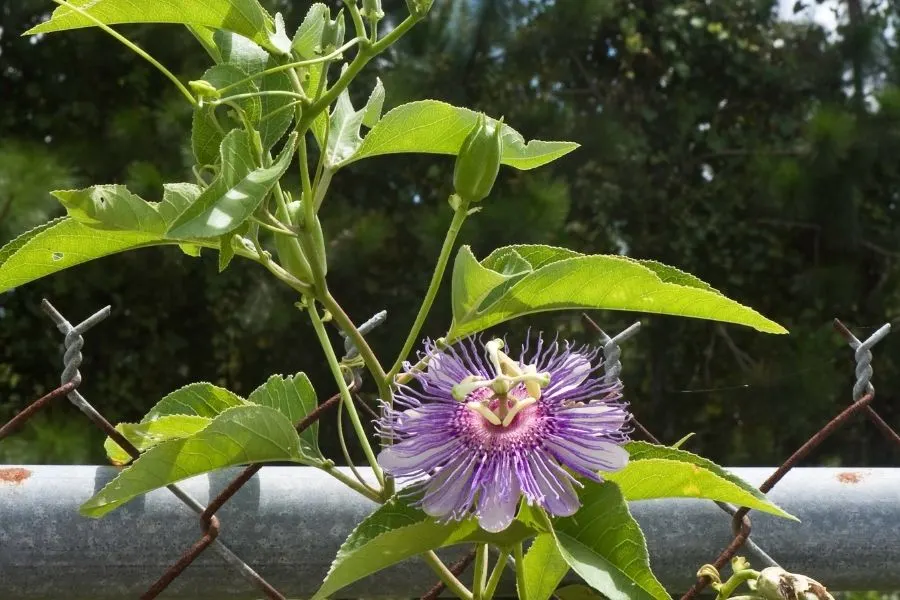Passion flowers are really something else. They look both strange and mesmerizing, and often like they belong on a coral reef, with colorful fish swimming by. Or maybe that’s just our imagination.
Maybe you just got a young seedling as a gift, and are wondering if it will give you actual fruit. That’s a very good question, since passion flowers are often used as decoration but you don’t see them fruiting all the time.

Are passion fruit and passion flower the same ?
Yes, passion fruit and passion flower are essentially the same plants. It is the main representative of the Passiflora genus, with some species bearing edible fruit and others being used for ornamental purposes.
Passion flowers are often used for ornament, since they grow very well, very quickly, and are great as a fence covering, or to cover up something.
Not all passion flowers produce fruit
Now, not every passion flower will bear fruit. At least not the way you may be thinking. The ones used for fruit, the fruits we can buy and eat, are the Passiflora edulis, and they diverge into two subtypes.
The first is Passiflora edulis edulis, the one that turns into the purple passion fruit we all know. And the second is Passiflora edulis flavicarpa, which turns yellow when the fruit is perfectly ripe.
Aside from these two, there are the ornamental passion flower varieties. Each of these produces fruit, but they’re not well documented. They’ve been bred for their flowers, not for the fruit. Some are horticultural hybrids, and some are found in the wild. After all, Passiflora is a wide genus.
You can also find Passiflora species that are closely related to passion fruit, but are in fact the flowers of the granadilla. The word maracuja gets thrown around a lot, and it sometimes applies to passion fruit, sometimes granadilla, sometimes both. It really depends on who you ask.
Read also: Top 4 Reasons Why Passion Fruit Is So Expensive
How passion flower got its name
The passion flower got its name from missionaries that first came to Brazil to spread Christianity. To them the flowers’ five stigmas resembled the five wounds inflicted during Jesus’ crucifixion, and was named after Jesus’s passion.
The Latin name thus became Passiflora, and once translated into plain English it became passion flower. Naturally, the fruit that resulted from this flower was then name passion fruit.
In Latin America the fruit already had a name, and that was and still is maracuja. Not only that, but granadilla (a fruit) is also in the Passiflora genus, so you will encounter it too when looking for ornamental flowers.
Passion fruit grows on vines, produces passion flowers
Passion flower, for all its alien yet mesmerizing flowers, grows abundantly. It doesn’t always produce the best fruit, as it’s a bit finicky when you grow it for plenty of edible, sweet fruit. But as an ornamental plant, oh boy does it grow ! It can grow 3-4 feet in height in a year, and it will continuously expand.

This is because it needs to grow on new wood, it doesn’t really regrow. So each year it needs to be cut back, otherwise it will run wild in your garden.
Most of the time it grows on vines, especially if you get the ornamental type. These vines grow some really thick, strong ‘legs’ and they get very heavy, very fast. You need to be careful and provide the plants a sturdy trellis to climb on, otherwise they’ll climb whatever they can.
If you’ve planted the seeds from a passion fruit and it doesn’t really yield a lot of fruit, or not the best fruit, you can still enjoy the flowers.
Passion fruit and flowers are native to Latin America
These beautiful plants are native to Mexico, Central and South America, but can be found all over the American continent nowadays. They grow best in very warm, tropical climates and need plenty of sunshine and water. They also need the best draining soil you have, one that clings to a bit more water than an orchid soil.
So if you’re ever looking for a new and interesting passion flower to add to your collection, a vacation to a tropical zone might net you a new addition. Or, you can try visiting a Latino market, they’re bound to a have a passion flower nursery.
Read Also: Passion Fruit Substitutes
How to tell when passion fruit is ready to pick
If you’ve got your flowering vine all established and it’s growing its fruit, you need to know when to pick it. Passion fruit has this annoying habit of falling off the vine when it’s ripe. It can really catch you by surprise, and one morning you’ll want up with 5-8 fruits on the ground.
So here’s some pointers. First, look at the fruit. It should be uniformly colored, and possibly a little bit wrinkly. A perfectly smooth fruit may still be a bit underripe.
Then tug the fruit a little. If it’s ripe, it will come off the vine easily, you won’t have to pull hard.
And finally, look to see there is no green tinge left on the fruit itself. This means the fruit is ripening, and is safe to pick, even now. It will be a little underripe, but it will soften and ripen on the counter in the next 3-5 days.

